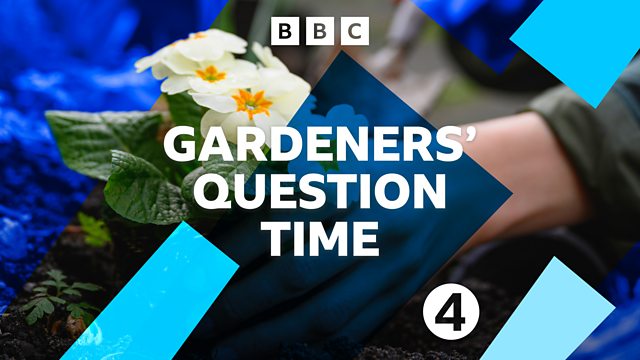Hadlow College, Kent
Eric Robson hosts the horticultural panel programme from Hadlow College in Kent. Matt Biggs, Anne Swithinbank and Pippa Greenwood answer the questions from the audience.
Eric Robson hosts the horticultural panel programme from Hadlow College in Kent.
Matt Biggs, Anne Swithinbank and Pippa Greenwood answer the questions from the audience on trees suitable for small gardens, making peace with pests, and plants fit for a queen. They also take time to reminisce on their own days as horticultural students.
And Eric takes a look around Down House, home of keen botanist Charles Darwin and where he penned On the Origin of Species.
Produced by Dan Cocker
Assistant Producer: Hannah Newton
A Somethin' Else production for Â鶹ԼÅÄ Radio 4.
Last on
More episodes
Previous
Next
Questions and Answers
Q – As a professional gardener I am often asked for a plant that flowers for twelve months of the year, is evergreen, does well in full sun or deep shade, wet or dry, and needs no maintenance… how would the panel answer this question?
Pippa – I always point out that one plant would be boring! Seasonal differences keep things interesting.
Matt – You can get one plant with lots of different elements – Amelanchiers for example
Ìý
Q – My fifteen-year-old ‘Autumn Bliss’ raspberries no longer fruit very much.Ìý Should I dig up and start again?
Pippa – Much as I hate getting rid of things I think the writing is on the wall for them. Raspberry canes are remarkably inexpensive for how much you get from them.Ìý Put them on a new piece of ground. ‘Autumn Bliss’ is great.Ìý ‘Joan J’ too.
Anne – Make sure the ground is well-drained. Raspberries need good drainage.
Ìý
Q – Do the panel have suggestions for trees for small gardens which are good for wildlife and attractive?
Anne – Apple trees. I would go for an edible or cooking variety.Ìý
Matt – Pyrus ‘C³ó²¹²Ô³Ù¾±³¦±ô±ð±ð°ù’. Malus – there’s a little one called ‘Evereste. Sorbus are great for flowers and fruit – there’s one called Sorbus commixta which is very good.
Pippa – Most of the ornamental Malus too.Ìý Also, make sure you’ve got some Ivy running up and through things too – great for birds and insects. Not a tree, but for bees there is nothing better than Ceanothus.Ìý
Ìý
Q – Can the panel suggest ways of keeping peace in the garden, as waging war on pests could be creating super-pests?
Anne – That does apply to things like Whitefly because they have such short life cycles they are able to breed so fast and breed immunity to pesticides.Ìý Really, to avoid this you’d have to stop spraying and you’d have to rely on forest garden principles and stop tampering with the soil so as to avoid disturbing mycorrhizal fungi.Ìý Some plants are good at fixing nitrogen deficiency – plants like the Sweet Gale or Myrica gale a native that will live in swampy places.Ìý This will make the plants more resistant and you won’t have to rely on sprays and insecticides as much.
Pippa – Gardening is desperately artificial but gently so! I’m an advocate of biological control – nematodes, encouraging ladybirds to control aphids, putting up barriers to stop pigeons eating brassicas etc – and that isn’t going to have a significant effect on the evolution of pests.
Ìý
Q – I’ve got quite a lot of Montbretia – it grows very well and has lots of foliage but not much in the way of flowers.Ìý How can I encourage more flowers? Soil is clay but with lots of organic material in it and it’s in mixed light.
Ìý
Eric – This is what we call Crocosmia these days
Anne – It might depend on what type you have
Matt – ‘Lucifer’ is the strongest type of Crocosmia. Continue improving the soil to avoid too much water in winter and not enough in summer – a problem with clay. Go for a vigorous sort like ‘Solfatare’. ‘Norwich Canary’ too. ‘Spitfire’, ‘Lucifer’, ‘Hellfire’ are good options as well.
Ìý
Q – For the last couple of years some of my Azaleas have had Azalea Gall – I’ve rubbed them off but it seems to weaken the plants.Ìý Am I wasting my time?
Ìý
Pippa – It’s an exciting looking fungus! It’s a fungus called Exobasidium which causes this swelling and distortion but I’ve never seen it cause a significant change in flowering or the general vigour of the plant.Ìý I suggest you pick them off when they’re still green, wash your hands, keep an eye out for fungus gnats – they can spread the infection as they zig-zag around, water a bit less, then concentrate on a little extra TLC – maybe a little extra feed – and it should be fine.
Ìý
Q – My garden will be open on June 10th for the Queen’s 90th birthday – what can I plant for a good show at that time?
Anne – You haven’t got very long! You won’t get anything from seed so you’ll need to buy bedding plants.Ìý Slightly larger ones like Osteospermums or Dimorphotheca – the African Daisies – they should move pretty quickly.
Matt – Hanging baskets filled with Petunias, Fuchsias, blue Lobellias, white Alyssum, red Salvias.Ìý Make sure you cram the baskets full so you get a nice sphere of colour.
Pippa – If you have a greenhouse, I’d pot up lots of things into good-sized pots, bring them on the greenhouse and then put them out on the day! Otherwise you’ll be running a risk with the unpredictable weather!
Broadcasts
- Fri 4 Mar 2016 15:00Â鶹ԼÅÄ Radio 4
- Sun 6 Mar 2016 14:00Â鶹ԼÅÄ Radio 4
Six of GQT’s naughtiest gardening innuendos
When Gardeners' Question Time got mucky.
Podcast
-
![]()
Gardeners' Question Time
Horticultural programme featuring a group of gardening experts


